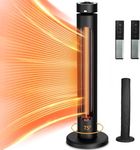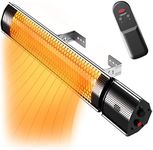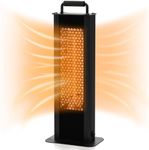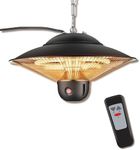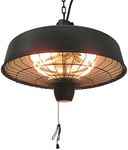Buying Guide for the Best Electric Patio Heaters
Choosing the right electric patio heater can transform your outdoor space into a cozy retreat, even when the temperatures drop. The key to selecting the best heater for your needs is understanding the various specifications and how they align with your specific requirements. Consider the size of the area you want to heat, the typical weather conditions in your area, and how often you plan to use the heater. By focusing on these factors, you can ensure that you select a heater that provides the right amount of warmth and comfort.WattageWattage indicates the power output of the heater and directly affects how much heat it can produce. Higher wattage means more heat, which is ideal for larger spaces or colder climates. Typically, patio heaters range from 1,500 to 5,000 watts. For small patios or balconies, a heater with lower wattage (around 1,500-2,000 watts) may suffice. For larger areas or open spaces, consider a higher wattage to ensure adequate warmth. Assess the size of your outdoor area and typical weather conditions to determine the appropriate wattage for your needs.
Heating Element TypeThe heating element type affects the efficiency and type of heat produced. Common types include halogen, infrared, and carbon fiber. Halogen heaters provide instant heat and are often more affordable, but they can be less efficient over time. Infrared heaters are efficient and provide a more natural warmth, similar to the sun's rays, making them ideal for larger spaces. Carbon fiber heaters are known for their durability and energy efficiency, offering a gentle and consistent heat. Consider how quickly you need the area to heat up and the type of warmth you prefer when choosing the heating element.
Mounting StyleMounting style refers to how the heater is installed or positioned. Options include freestanding, wall-mounted, and tabletop models. Freestanding heaters are versatile and can be moved around, making them suitable for flexible outdoor setups. Wall-mounted heaters save space and are ideal for permanent installations in smaller areas. Tabletop heaters are compact and perfect for intimate settings or small gatherings. Think about your patio layout and how you plan to use the space to decide on the best mounting style for your heater.
Weather ResistanceWeather resistance is crucial for outdoor heaters, as they need to withstand various weather conditions. Look for heaters with a high IP (Ingress Protection) rating, which indicates their resistance to dust and water. A higher IP rating means better protection against the elements, ensuring longevity and safety. If your patio is exposed to rain or moisture, prioritize a heater with a robust weather resistance rating. Consider the typical weather in your area and how exposed your patio is to the elements when evaluating this feature.
Safety FeaturesSafety features are essential to prevent accidents and ensure safe operation. Common safety features include tip-over protection, overheat protection, and cool-touch exteriors. Tip-over protection automatically shuts off the heater if it is knocked over, while overheat protection turns off the heater if it gets too hot. Cool-touch exteriors prevent burns if someone accidentally touches the heater. Evaluate the safety features based on your household needs, especially if you have children or pets, to ensure a safe outdoor heating experience.


